|
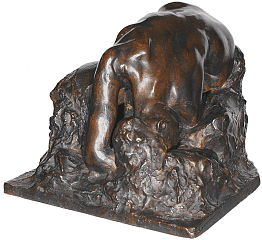 Rodin's 'Danaid' is an adaption of the Greek myth of the 50 daughters of King Danaos of
Argos, the Danaids. To reconcile with his brother Danaos, Aegyptos, father of
50 sons, proposed his sons would marry to Danaos's daughters. Although
Danaos seemingly agreed with the wedding, he instructed the brides to
murder their bridegrooms during the wedding night, and all except
one stabbed their husbands. As a penalty, the Danaids were forced to fill
their jugs with water in the Hades; since these urns were perforated, their
efforts were condemned to be in vain - another variation of the Sisyphus
and Prometheus theme, whose penalties also were characterised by endless
repetition.
Rodin's 'Danaid' is an adaption of the Greek myth of the 50 daughters of King Danaos of
Argos, the Danaids. To reconcile with his brother Danaos, Aegyptos, father of
50 sons, proposed his sons would marry to Danaos's daughters. Although
Danaos seemingly agreed with the wedding, he instructed the brides to
murder their bridegrooms during the wedding night, and all except
one stabbed their husbands. As a penalty, the Danaids were forced to fill
their jugs with water in the Hades; since these urns were perforated, their
efforts were condemned to be in vain - another variation of the Sisyphus
and Prometheus theme, whose penalties also were characterised by endless
repetition.
Additionally, Mary Levkoff points to the ancient
sacramental ceremony of pouring water at the marriage; as a further
association with the water theme, she mentions that Danaos was skillful at
digging wells - an important quality in Argos where drinkable water was
precious.
Aida Audeh beliefs that Canto XXII of Dante´s Inferno
provides us with the origin of the Danaid character: immersed in a
boiling pitch of tar, the sinners momentarily rise over the surface,
showing their curved backs like dolphins. I do not see a stringent
connection, however, between these barrators (swindlers in public
office) and the traitorous brides.
Although Georges Grappe claimed that a - possible preliminary - version of
'The Danaid' named 'Andomeda'
was meant to be part of 'The Gates of Hell',
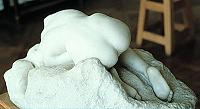 its purported presence in this monumental composition remains without
evidence.
Unproven remains also Monique Laurent's thesis that Camille Claudel was
Rodin's model for these sculptures
, although Elsen fancies Tancock's speculation that Rodin derived his
subject from a fatigued studio model that had rested herself in this
position.
Merging fact and fiction, Bruno Nuytten's movie 'Camille Claudel' with Isabelle Adjani
as Rodin's counterpart shows an exhausted
Camille kneeling on the floor leaning over against a piece of furniture.
its purported presence in this monumental composition remains without
evidence.
Unproven remains also Monique Laurent's thesis that Camille Claudel was
Rodin's model for these sculptures
, although Elsen fancies Tancock's speculation that Rodin derived his
subject from a fatigued studio model that had rested herself in this
position.
Merging fact and fiction, Bruno Nuytten's movie 'Camille Claudel' with Isabelle Adjani
as Rodin's counterpart shows an exhausted
Camille kneeling on the floor leaning over against a piece of furniture.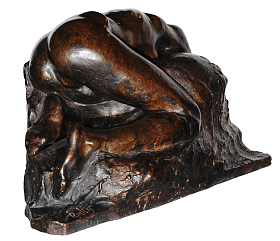
Whereas the back of 'Andromeda'
runs nearly parallel to the ground plane, 'The Danaid' has her body tilted to the left, the hips leaning to an edge of the rock that
looks as if extra designed for this support. Because of this additional slant, the arc of the torso's dexter half looks
dramatically stretched; the line from shoulder blade over rib cage down to the accentuated hip bone makes up for a highly differentiated lateral profile. Simultaneously, the right
buttock is lifted, revealing the cleavage between the girl's legs to the
spectator. While
Rodin's sculpture is supposed to show the punished maiden exhausted and frustrated
by her senseless duty, 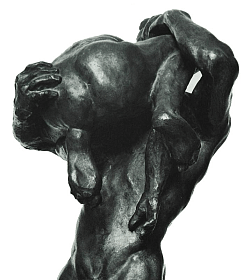 the water running from the vessel clenched under
her right arm, the grace and sensuality of her curved back and outstretched
bottom contain an outspoken erotic message, contrasted by the
innocence of a sleeping face: an ambiguity
typical of many Rodin works. In this sense, 'The Danaid' and - to a lesser
extent - 'Andromeda' represent the
widespread male sexual phantasy of the attractive young girl helplessly
exposed to overpowering masculine greed
; other relevant examples can be found in 'The
Minotaur' and 'Avarice and Lust', or in
'I
am Beautiful', offering an uninhibited, intimate view of 'The
Crouching Woman'. Seen from this perspective, 'The
Crouching Woman', created as early as 1880, has quite a resemblance to 'The Danaid'. the water running from the vessel clenched under
her right arm, the grace and sensuality of her curved back and outstretched
bottom contain an outspoken erotic message, contrasted by the
innocence of a sleeping face: an ambiguity
typical of many Rodin works. In this sense, 'The Danaid' and - to a lesser
extent - 'Andromeda' represent the
widespread male sexual phantasy of the attractive young girl helplessly
exposed to overpowering masculine greed
; other relevant examples can be found in 'The
Minotaur' and 'Avarice and Lust', or in
'I
am Beautiful', offering an uninhibited, intimate view of 'The
Crouching Woman'. Seen from this perspective, 'The
Crouching Woman', created as early as 1880, has quite a resemblance to 'The Danaid'.
The
'Danaid' was for the first time exhibited as an autonomous work in the
Gallery Georges Petit in 1889 and submitted to the Salon of 1890. Here, it
was purchased for the Musée du Luxembourg.
The
marble version now exhibited in the Musée Rodin (S.1155, 36 x 71 x 53 cm),
carved by Rodin's praticien Jean Escoula, shows the same smooth finish as
the Bust of Mme Vicuna.
Instead of tense and twisted muscles, we find a polished composition in
fin-de-siècle perfection; only the rock, from which the 'Danaid' seems to
emerge, has retained its rough surface - a juxtaposition very popular with
Rodin, 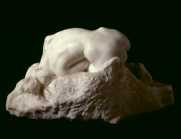 who had adapted this style from Michelangelo to suggest the non-finito
of his sculpture and the organic evolution of the figure from the block of
stone it had been "liberated" from. The wave-like lines of the back and the undulating long
hair, combined with this fluidity of execution, seem to make a rhyme to
the water theme associated with the Danaid's story. who had adapted this style from Michelangelo to suggest the non-finito
of his sculpture and the organic evolution of the figure from the block of
stone it had been "liberated" from. The wave-like lines of the back and the undulating long
hair, combined with this fluidity of execution, seem to make a rhyme to
the water theme associated with the Danaid's story.
Another marble example ist found in Finland, in the
Finnish National Gallery (dimensions given as 32 cm x 45 cm x 67 cm). Like
in the case of 'Fallen Angel', the marble versions have been used to
create bronze casts.
|
 Rodin's 'Danaid' is an adaption of the Greek myth of the 50 daughters of King Danaos of
Argos, the Danaids. To reconcile with his brother Danaos, Aegyptos, father of
50 sons, proposed his sons would marry to Danaos's daughters. Although
Danaos seemingly agreed with the wedding, he instructed the brides to
murder their bridegrooms during the wedding night, and all except
one stabbed their husbands. As a penalty, the Danaids were forced to fill
their jugs with water in the Hades; since these urns were perforated, their
efforts were condemned to be in vain - another variation of the Sisyphus
and Prometheus theme, whose penalties also were characterised by endless
repetition.
Rodin's 'Danaid' is an adaption of the Greek myth of the 50 daughters of King Danaos of
Argos, the Danaids. To reconcile with his brother Danaos, Aegyptos, father of
50 sons, proposed his sons would marry to Danaos's daughters. Although
Danaos seemingly agreed with the wedding, he instructed the brides to
murder their bridegrooms during the wedding night, and all except
one stabbed their husbands. As a penalty, the Danaids were forced to fill
their jugs with water in the Hades; since these urns were perforated, their
efforts were condemned to be in vain - another variation of the Sisyphus
and Prometheus theme, whose penalties also were characterised by endless
repetition. its purported presence in this monumental composition remains without
evidence.
Unproven remains also Monique Laurent's thesis that Camille Claudel was
Rodin's model for these sculptures
, although Elsen fancies Tancock's speculation that Rodin derived his
subject from a fatigued studio model that had rested herself in this
position.
Merging fact and fiction, Bruno Nuytten's movie 'Camille Claudel' with Isabelle Adjani
as Rodin's counterpart shows an exhausted
Camille kneeling on the floor leaning over against a piece of furniture.
its purported presence in this monumental composition remains without
evidence.
Unproven remains also Monique Laurent's thesis that Camille Claudel was
Rodin's model for these sculptures
, although Elsen fancies Tancock's speculation that Rodin derived his
subject from a fatigued studio model that had rested herself in this
position.
Merging fact and fiction, Bruno Nuytten's movie 'Camille Claudel' with Isabelle Adjani
as Rodin's counterpart shows an exhausted
Camille kneeling on the floor leaning over against a piece of furniture.
 the water running from the vessel clenched under
her right arm, the grace and sensuality of her curved back and outstretched
bottom contain an outspoken erotic message, contrasted by the
innocence of a sleeping face: an ambiguity
typical of many Rodin works. In this sense, 'The Danaid' and - to a lesser
extent -
the water running from the vessel clenched under
her right arm, the grace and sensuality of her curved back and outstretched
bottom contain an outspoken erotic message, contrasted by the
innocence of a sleeping face: an ambiguity
typical of many Rodin works. In this sense, 'The Danaid' and - to a lesser
extent - 